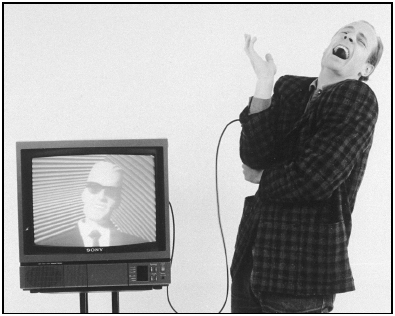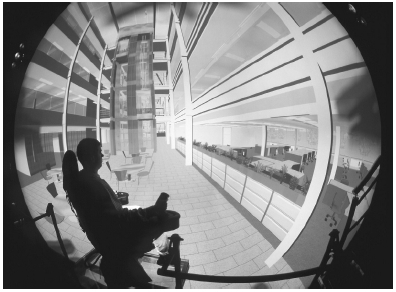Someday, every home may have its own Holodeck. If that happens, how will virtual reality change people’s lives?
via: Which World Is Real? The Future of Virtual Reality – A Virtual Future, Changing the Brain, Connection or Isolation?, Computer Addicts.
Most experts think that virtual reality, at least beyond the level shown in today’s video and computer games, will not become widespread any time soon. Fully immersive VR technology is still expensive and undependable. Most businesses have not wanted to invest in it. CyberEdge Information Services, a research and marketing firm that covers the industry, stated that virtual reality or visual simulations earned $36.2 billion in 2002, up from $22 billion in 2001. That figure seems large, but it is only a tiny fraction of the amount that the whole computer industry makes.
A Virtual Future
On the other hand, computers are likely to continue growing in speed and in power very quickly, and virtual reality technology will probably improve along with them. Back in 1965, Gordon Moore, a cofounder of Intel Corporation, now a well-known maker of computer chips, proposed what has come to be called Moore’s Law, which has often been interpreted to mean that computing power doubles every year or two. In other words, a computer system that costs $1,000 today will do twice as much, twice as fast, as a system that sold for that price about a year and a half ago—or, put another way, a system with the same power as one that cost $1,000 a year or two ago will cost only $500 today. Amazing as it seems, several decades of experience have proved Moore’s Law to be true.
It looks likely, then, that by, say, 2015 or 2020, computer systems that deliver convincing, immersive, reasonably reliable virtual reality will cost no more than a big-screen television does now. Most businesses and many homes will have them. Virtual reality entrepreneur John C. Briggs, for one, predicted in the May 2002 issue of Futurist magazine that “in the next 10 to 20 years, VR experiences will be fully integrated into real life.” 35 Looking farther ahead, Ken Pimental and Kevin Teixeira claimed in the book Virtual Marketing: Through the New Looking Glass that “within one hundred years virtual reality could become a semi-invisible service in society, like telephones, light switches, books, and television—a tool for communication, work, and pleasure that we use without thinking about it.” 36
Some people paint a rosy picture of what life would be like if virtual reality were everywhere. In an article in the journal of the Association for Computing Machinery, multimedia expert Ramesh Jain wrote: “You might experience your friend’s wedding in India, seeing what is happening, feeling the warm, humid air of the wedding hall, listening to conversations and the wedding music, and enjoying the taste and aroma of the food being served. You might experience all that and more while sitting at home in Montana on a frigid January morning.” 37
Boosters of virtual reality believe that it will greatly enhance education, science, industry, art, and entertainment, as it has already begun to do. They say it will simplify many tasks and let people express their creativity in new ways.
Changing the Brain
Others think VR may have much less helpful effects. They point to physical and mental problems that some people who use the technology have already experienced. Such problems go far beyond the annoying nausea of simulator sickness. Makers of flight simulators, for instance, found out decades ago that pilots who had used such simulators sometimes made mistakes during actual flying because of differences between the simulated environment and reality. For one thing, simulators cannot mimic the effects of acceleration that a pilot feels during flight. When a pilot experiences these new sensations in the air, confusion results. The problem is temporary, but because of it, pilots are not allowed to fly until they have been away from simulators for at least twenty-four hours.
Some other people have also reported readjustment problems after using virtual reality or doing other intensive work with computers. After researching on the Internet for some time, for example, reporter Chip Brown wrote that he
woke one night from a peculiar dream, disturbed . . . by . . . the way the scenes had changed; they had not unfolded in a horizontal flow, the movie-like montage of a typical dream presentation, but had scrolled past, rolling up vertically from bottom to top. And my focus had shifted, too, as if the inner observer were no longer located behind my eyes, but had been projected 24 inches forward, out of my body, a displacement roughly equal to the distance between my desk chair and the computer monitor. The conclusion was inescapable. I had become a [computer] mouse. Not even a mouse. A mouse indicator. A cursor. 38
These temporary effects have made some researchers wonder whether long-term use of virtual reality might cause permanent changes, especially in children, whose brains are still developing and therefore are more easily modified than those of adults. A few even think it might change adults’ brains permanently. Psychologist and science writer Richard DeGrandpre, author of Digitopia , warns that steady exposure to virtual reality could alter the way people perceive the real world: “Conscious reality changes as the software of everyday life changes, and remains changed thereafter. . . . Chronic exposure to simulated ideas, moods, and images conditions your sensibilities . . . for how the real world should look, how fast it should go, and how you should feel when living in it.” 39
Connection or Isolation?
People also argue about the possible social effects of having most personal interactions occur online, in the virtual or cyberspace world. Supporters of virtual reality and online communities say that future VR and computer technology could change the nature of communication, bringing people around the world closer together.
Even today, some young people who share both physical and virtual communities use Internet-connected cell phones and related devices to keep in constant touch. Some writers, such as the late Michael Dertouzos, professor of computer science at MIT, have thought that most people will share this kind of constant communication in the future. Howard Rheingold has pointed out, however, that such interlinking could be used for either good or harm. It could let massive numbers of people work on projects together or help each other after a disaster, for instance. On the other hand, it could help terrorists coordinate their activities so they could attack many locations at the same time.

Supporters also say that the opportunity to lead a “second life” limited only by the imagination can be a great help to people who have little chance to succeed in their everyday life. For instance, John C. Briggs writes:
VR-enhanced communications will allow those with restricted mobility, confined to their homes, to interact more fully and humanly with the outside world. Because they will use avatars and augmented and assistive technologies on the Internet, they need not reveal to anyone that they have a disability. People with learning disabilities will be able to share their experiences, feelings, and knowledge using communications assistance and augmentation. 40
People who distrust cyberspace, however, say that withdrawing to an online environment may become a way of avoiding real-life problems rather than trying to solve them. These critics also fear that the chance to represent oneself, and to see others, as beautiful or fantastic avatars could reinforce prejudices against people whose real bodies are less than perfect. Furthermore, a few people use cyberspace disguises for harmful purposes, as when a child molester pretends to be another child or teen in order to lure a potential victim into a face-to-face meeting.
Internet pioneer Clifford Stoll is one prominent commentator who believes that cyberspace society is shallow at best. In Silicon Snake Oil , originally published in 1995, he wrote, “Electronic communication is an instantaneous and illusory contact that creates a sense of intimacy without the emotional investment that leads to close friendships.” 41 Too much dependence on this kind of communication, he and others fear, can isolate people from real relationships with family and close friends.
Computer Addicts
The isolation is worst for the small number of people who have apparently become addicted to cyberspace gaming. They spend nearly all their time online, ignoring parents, friends, schoolwork, or jobs. They come to regard the imaginary world of the games as more important and more “real” than the world outside. (The problem—or at least the accusation—of addiction is not limited to computer games and online communities. It also occurred with live fantasy role-playing games in the 1970s and 1980s.) A few game addicts have even killed themselves rather than give up the activity.
Supporters of online games and other forms of virtual reality say that the cause of the addiction is the addicts’ psychological makeup, not the games themselves. “Computer games bring to the surface the problems of the individual,” says Maresa Hecht Orzack, a clinical psychologist who teaches at Harvard Medical School. “Many of these people . . . simply don’t want to deal with their everyday lives.” 42 If such people did not become hooked on games, these supporters say, they probably would be addicted to something else, such as drugs or gambling. Furthermore, people who favor gaming point out, only a tiny proportion of gamers let their hobby take over their lives. Rider University psychology professor John Suler, for one, claims that the media has greatly exaggerated the reality of Internet addiction.
Suler is one of many experts who feel that the way to keep virtual reality and cyberspace from causing isolation and addiction is to use them as supplements to face-to-face contacts, not replacements for them. He stresses “the importance of bringing together one’s online and offline living.” 43 Similarly, Joseph Tecce, associate professor of psychology at Boston College, writes, “Virtual reality cannot replace a warm smile, a firm handshake or a reassuring hug. It is essential to connect with someone in [face-to-face] conversation and to share good and bad feelings to ward off loneliness.” 44
Reshaping Social Attitudes
Supporters of realistic online games like The Sims , which lets players direct the lives of ordinary people in a virtual city, say that such games can help young people learn that actions have consequences. If a player does not give the Sim characters a chance to eat and sleep, for instance, the characters will become sick and even die. Critics, however, fear that such games could make players think that all consequences are temporary. Real life does not offer the chance to undo a serious mistake by creating a new character or starting a new round of play.
Some writers also say that playing violent, realistic computer games makes people more likely to be violent in real life. A few teenagers in fact have said that games like Grand Theft Auto inspired them to hurt or

kill real people. However, defenders of gaming protest that games do not force people to do anything. The true motivators of violence, they claim, are individuals’ psychological troubles, plus problems in society that many people would rather not discuss. As Computer Gaming World editor Robert Coffey puts it:
It’s oddly reassuring to be able to point at something you don’t understand and blame it for something else you don’t understand. Or don’t want to devote a whole lot of thought to. It’s a lot easier to hold Doom [a violent computer game] responsible for some horror than to figure out the role parenting, society, and good old-fashioned unexplainable craziness played. 45
Are Avatars Human?
These existing arguments about virtual reality’s effects on individuals and society are sure to grow more intense if immersive virtual reality environments become commonplace in the future. In addition, widespread virtual reality could raise entirely new ethical questions. For example, it might force people to redefine being human.
In addition to avatars, which stand in for real individuals, artists and businesspeople have created “people” who exist only in the virtual world. Probably the first was a character called Max Headroom, who appeared as part of a British music video program in 1984. Inventor and futurist Ray Kurzweil believes that by 2030, computer-created avatars and characters will become so convincing that no one will be able to tell the difference between real and simulated humans online. Norman I. Badler, professor of computer and information science at the University of Pennsylvania in Philadelphia, similarly predicts that in the future “virtual humans will see with synthetic vision, sense our (and each other’s) movements, know us and our actions, and respond in a coordinated

and context-appropriate manner. We will communicate with [them] as we communicate with [real] people . . . and use them as information sources, conversational partners, clerks, and complaint departments.” 46 If avatars and artificial characters become increasingly convincing and common, Badler points out, their use will raise “a multitude of copyright and privacy issues.” 47 Would one person be allowed to use the form of another as an avatar without obtaining permission? Would famous people such as movie stars, who often sell the right to print images of them, sell the right to use their images as avatars, too? And what if an avatar that looked like, say, a real mayor or senator made racial slurs or other remarks that would harm the reputation of the person supposedly making them? How would people know whether the real person had actually said such things? If someone else had put the words into the avatar’s mouth, would this be a criminal act?
Badler believes that ethical issues raised by extremely realistic, complex avatars, gifted with some form of artificial intelligence, could reach far deeper than this. If their programming permits them to make independent decisions, he asks, should they be held responsible for their actions? Could they be punished if, for instance, they deliberately lied to or about someone or cheated someone out of money? At what point would they demand, or deserve, the rights and responsibilities granted to flesh-and-blood human beings?
Withdrawing from Reality
Some thinkers even believe that, for better or worse, constant to virtual exposure reality could completely transform human consciousness. Critics fear that large numbers of people might come to prefer virtual worlds to the real one. Like the philosopher Plato, they would feel that the everyday world is an imperfect reflection of an ideal, but, in opposition to the prisoners in Plato’s imaginary cave, they would see the ideal world as the one shown on the screen and the imperfect world as the one outside. Why let others see a flawed real body when online interactions can be delivered through a beautiful, sexy avatar? Why bother with a boring real life when, in an online world, a person can fly through the air, have adventures in distant or imaginary lands, and build a house or even a city in any form he or she wants?
The idea that people might choose to ignore the actual world and withdraw into virtual reality began to concern writers and thinkers long before VR technology actually developed. In Summa Technologiae , a book of essays about the future published in 1964, Polish science-fiction writer Stanislaw Lem described an imaginary machine that he called a Phantomat. According to an essay by author John Gray, Lem pictured the dangers of permanent immersion in the Phantomat’s virtual reality this way:
The more realistic the virtual world the machine creates, the more imprisoned we are in our imaginations. As our embodied selves, we interact with a world we know only in part, and which operates independently of our desire. In contrast, the virtual worlds we encounter in the Phantomat are human constructions. Fabricated from our dreams, they are worlds in which nothing can be hurt or destroyed because nothing really exists. In short, they are worlds in which nothing really matters. 48
Richard DeGrandpre, like Lem, believes that once people become used to virtual worlds, the real world will no longer satisfy them, and they will withdraw from it. This will happen, he thinks, not only because virtual reality will be so appealing, but because social, environmental, and other problems will have made the real world just the opposite. “The ultimate reason we’re apt to be taking flight from material reality,” he writes, “is to escape the expanding unpleasantness of our inner and outer lives—a melange [mixture] of boredom, restlessness, . . . anxiety, and depression.” 49
Shared Dreams
Other commentators, however, think that the power to share virtual worlds could be a beautiful thing, raising human consciousness to new heights. Jaron Lanier, the man who coined the term virtual reality , said in a 2002 inteview that shared online gaming already is “like a technology-enhanced version of shared make-believe. . . . With language, we trade symbols, but with this we trade something beyond symbols. We trade experience.” He believes

that future VR technology will “provide a form of intentional, waking-state, shared dreams.” 50 A book and online project about multimedia and virtual reality sponsored by ArtMuseum.net goes even further:
Interactive multimedia is experiential and sensory, you don’t simply observe the object, you are the object. You enter into and become part of the landscape, not just a detached observer. The medium functions as an extension of the self, a reconfiguration of identity, dreams, and memories—blurring the boundaries between self and exterior. . . . The revolutionary nature of multimedia . . . lies in its potential to transform the human spirit. 51
